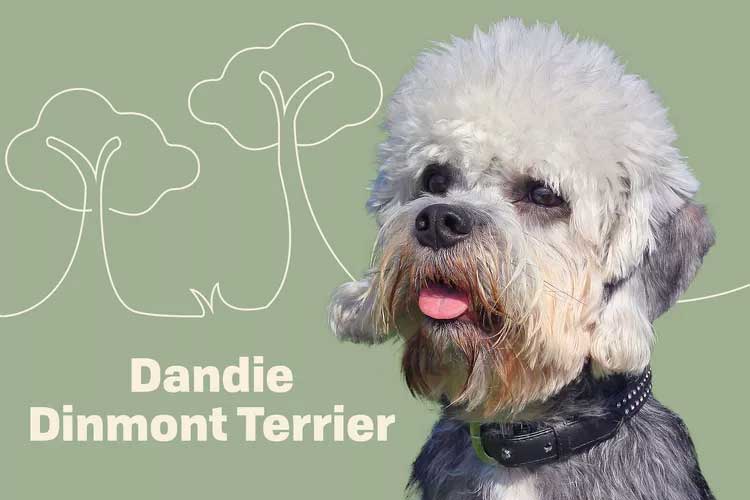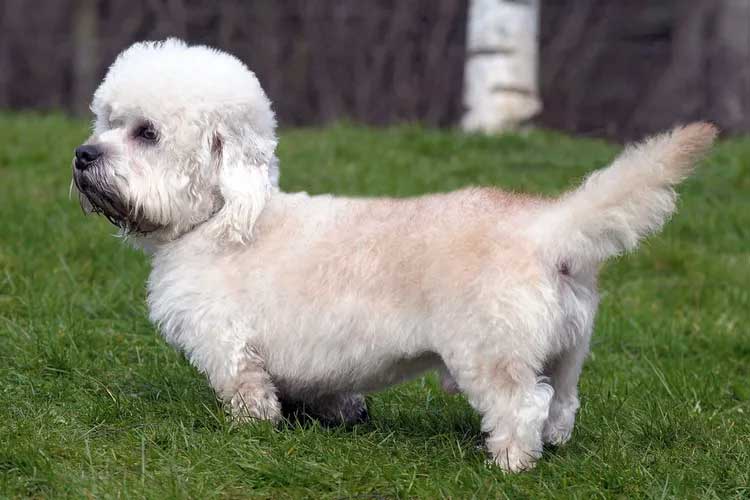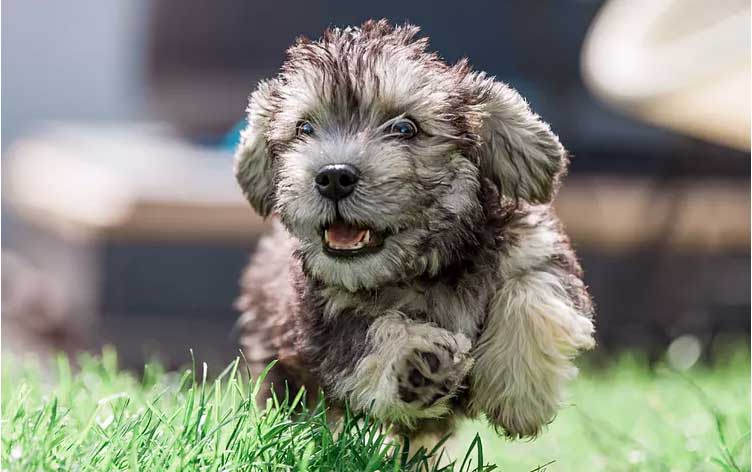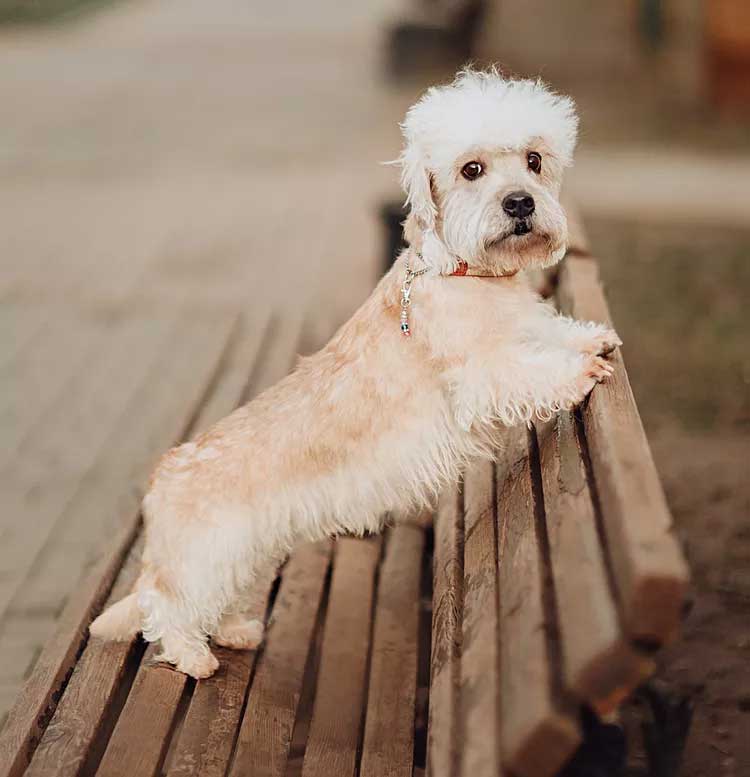The Dandie Dinmont terrier is a one-of-a-kind dog in looks and in personality. Learn more about what it takes to live with this spunky, silly breed.

Dandie Dinmont Terrier Overview
| OFFICIAL NAME | Dandie Dinmont Terrier |
| COMMON NAME | Dandie Dinmont Terrier |
| PET HEIGHT | 8 to 11 inches |
| PET WEIGHT | 18 to 24 pounds |
| LIFESPAN | 12 to 15 years |
| GOOD WITH | cats, children, dogs, families, seniors |
| TEMPERAMENT | friendly, outgoing, willful |
| INTELLIGENCE | high |
| SHEDDING AMOUNT | infrequent |
| EXERCISE NEEDS | medium |
| ENERGY LEVEL | active |
| VOCAL LEVEL | when necessary |
| DROOL AMOUNT | low |
| BREED GROUP | terrier |
| BREED SIZE | small (0-25 lbs.) |
| COAT LENGTH | short |
| COLORS | blue, cream, fawn, gray |
| PATTERNS | bicolor |
| OTHER TRAITS | apartment-friendly, easy to train, high prey drive, requires lots of grooming |
Known as the "gentlemen of the terrier group," the Dandie Dinmont terrier is an affectionate social butterfly with a distinct doggy hairdo that's hard to miss.
Originally bred to "go to ground" after otters and badgers, this Scottish pup's hunting days are far behind him. In fact, Dandies are exceedingly rare today, and you might not ever see one outside of the show ring. But if you're lucky enough to have one in your family, you'll have a devoted, happy companion.
Appearance
The Dandie Dinmont is no run-of-the-mill terrier. They come in one of two colors—mustard or pepper. Pepper pups can range from a "dark bluish black to light silvery gray," according to the breed standard, while mustard Dandie Dinmont terriers can range from a red-brown to light fawn. Their coat is wiry with lighter, silky fur on their legs and underside.
But what really stands out about this breed is the large, round head. The Dandie Dinmont terrier's domed noggin is perfect for housing his big brain and sports a fluffy tuft of impossibly soft fur (ideal for head pats!). This silky head hair is also lighter in color, matching the hair on his underside.
Dandies are also rather stout, standing only between 8–11 inches while weighing up to 24 pounds. There's a natural curve in their bodies (according to the Dandie Dinmont Terrier Club of America (DDTCA), "there are no straight lines"). Floppy ears frame their wide head and large, dark hazel eyes complete their one-of-a-kind look.
Temperament
Along with their unique appearance, Dandie Dinmont terriers also boast a charming and funny personality. Sandra Hickson, Judges Education and National Specialty Chair at the DDTCA, says they can be quite gamey and terrier-ish thanks to their origins as four-legged vermin control, but they also make great house dogs.
"They're known as 'the gentlemen of the terrier group,'" she says. "And so while they're happy to go out and do whatever kind of activity you like to do, they're also really happy sleeping on the couch next to you."
Dandies are happy pups and make great family dogs. They typically get along with cats and other dogs, especially when introduced and socialized at a young age, and adore kiddos most of all.
"They really do like children a lot," Hickson says. "They like people a lot. Just in general, they're really social."
Dandies can be quieter than most of their terrier cousins, especially when trained from a young age. But that doesn't mean they don't bark at all—in fact, Dandie Dinmont terriers are known to sound the alarm when they see a squirrel, hear someone approaching their house, or if they're bored (giving them lots of toys will keep boredom at bay).
Living Needs
Though they're described as little gentlemen, Dandie Dinmonts are still terriers. And because they were originally bred to hunt vermin, that instinct still remains strong inside them today. Hickson says it's probably not the best idea to bring a Dandie Dinmont terrier home if you have hamsters or guinea pigs, and you can count on your pup to fixate on the neighborhood wildlife."They will go nuts if there's a squirrel in the backyard," she says. "Or if you're walking and you see a squirrel go up a tree, they will lose their mind. If you have moles or gophers, be prepared for there to be a crater in the backyard while they go hunting for it—because they will."
Because of this strong prey drive, it's important to keep your Dandie Dinmont terrier safely in a fenced-in space (always under your supervision) and on a leash during walks. Always make sure he's microchipped, too, in case he does dart off.

A Dandie can thrive in virtually any living situation, including apartments, as long as he gets an opportunity to stretch his legs outside every day. Their exercise needs vary—Hickson says some might want to run around an agility course while others are content with snoozing on the couch all day—but a daily walk should keep most Dandie Dinmont terriers happy.
Care
One major perk of having a Dandie Dinmont terrier at home: You won't have to use a lint roller before leaving the house. Their distinct hairdos (a hard jacket and fluffy furnishings) don't really shed, though they are not considered to be a "hypoallergenic" breed.But just because the fur won't fly doesn't mean their care routine is hands-off. In fact, grooming a Dandie Dinmont terrier is a fairly involved process. Hickson says these pups need to be brushed every other day depending on your Dandie's specific coat.

"Dogs that are brushed and kept up stay cleaner and mat less," she says. "So if you can take 10 minutes a day and brush [him], it's really good for the dog and it's good for bonding."
Dandie Dinmont terriers also need regular trips to the groomer. You can choose to have them hand stripped (where dead hairs are removed by the root) or clipped. Hickson says if you choose to hand strip your Dandie, you'll need to take him to the groomer at least once a month. Clipping his fur, on the other hand, should be done every six to eight weeks; he also won't maintain the same mustard or pepper color with regular clippings.
Along with grooming upkeep, Dandies need to have their nails trimmed and teeth brushed regularly to stay healthy.
When it comes to training, these brainiacs are eager to please the people they love, but they can be a bit independent-minded and think they know best.
"Experienced owners are preferred to get this breed started on the right track," says Chyrle Bonk, DVM, veterinary writer with Hepper. "They may also have a little bit of a 'big dog in a little body' issue ... and will need a little guidance to tell them what they can and can't handle."
But with positive reinforcement and consistent training, Bonk says these pups are capable of learning quickly.
Health
The typical Dandie Dinmont terrier lifespan is a robust 12–15 years, and they're incredibly healthy dogs.The only inherited condition Dandies can be susceptible to is glaucoma, which can cause blindness. The Canine Health Information Center recommends all Dandie Dinmont terriers complete annual eye exams. According to the DDTCA, the club is "committed to eradicating [glaucoma] completely," so make sure your Dandie Dinmont terrier breeder has tested their dogs for the condition.
Aside from glaucoma, Bonk says lymphoma seems to be slightly more common in Dandies than in other dog breeds.
History
Though the Dandie Dinmont didn't become known by name until the 1800s, the terriers were recorded as a distinct breed in the early 1700s, according to the DDTCA. They likely descended from dogs found along the England-Scotland border. The dogs were popular with families and groups of travelers for their hunting prowess; Dandies were known to be effective exterminators of rats, foxes, otters, and badgers.According to the DDTCA, the Dandie Dinmont terrier is the only dog breed named after a literary character. Scottish author Sir Walter Scott published Guy Mannering in 1815, and the novel featured a farmer named Dandie Dinmont who owned six of these little terriers.
A real-life farmer named James Davidson had a fondness for the breed and collected the dogs (and named them all either "Mustard" or "Pepper"). Because he resembled the farmer in Guy Mannering, Davidson's friends started calling him "Dandie Dinmont." The name stuck—not to Davidson, but to the scrappy little dogs.
But despite their long history, the Dandie Dinmont terrier isn't a breed you'll typically find at the dog park. The United Kennel Club classifies the terriers as a "vulnerable native breed."
"There are not that many breeders in the U.S., so if you decide that you want a Dandie, please be patient," Hickson says. "It's going to be unlikely that you're going to find one immediately. You're probably going to have to wait several months and be on someone's waiting list, but they are really worth your patience and effort because they are a great breed."
Fun Facts
The American Kennel Club recognized the breed in 1886.The British Dandie Dinmont Terrier Club formed in 1875, and it's the second-oldest breed club in the world.
In the early 1700s, a bagpiper named Willie Allan made extra money renting his dog out to exterminate vermin. According to the DDTCA, the Duke of Northumberland offered Allan an entire farm in exchange for his dogs' services.